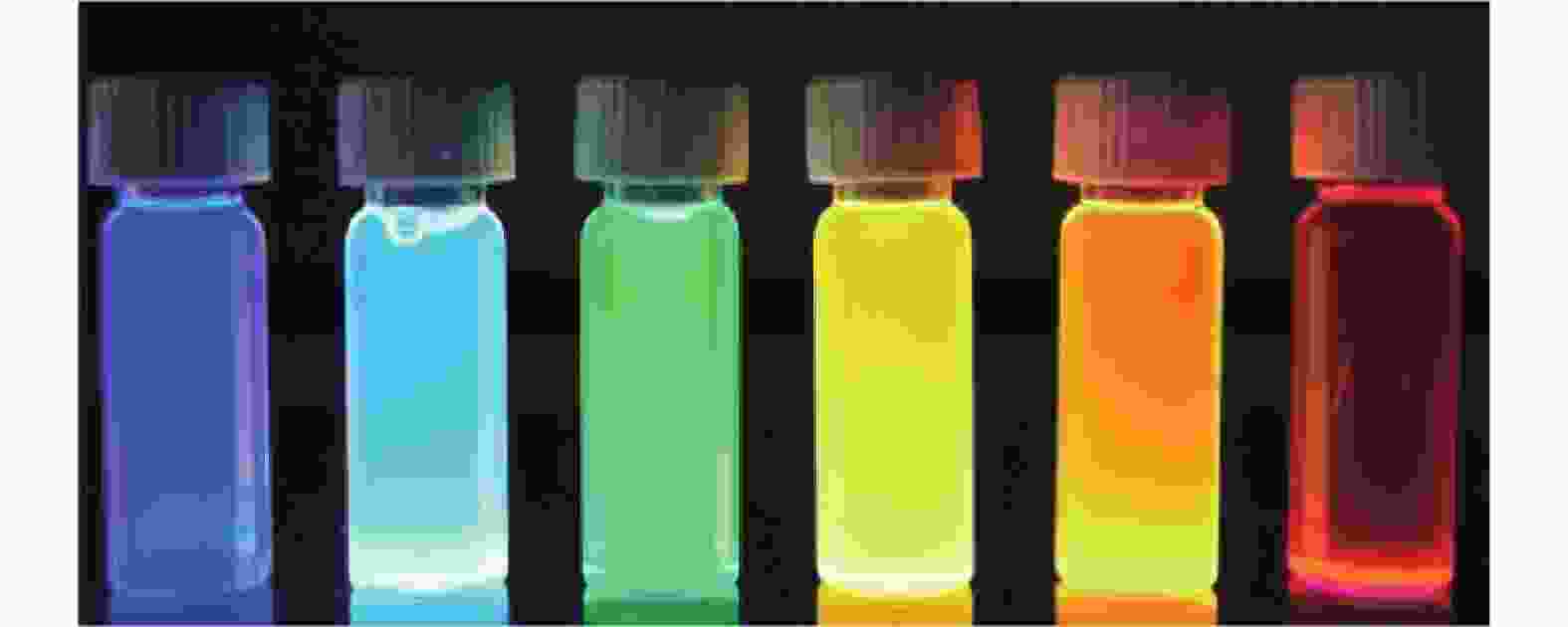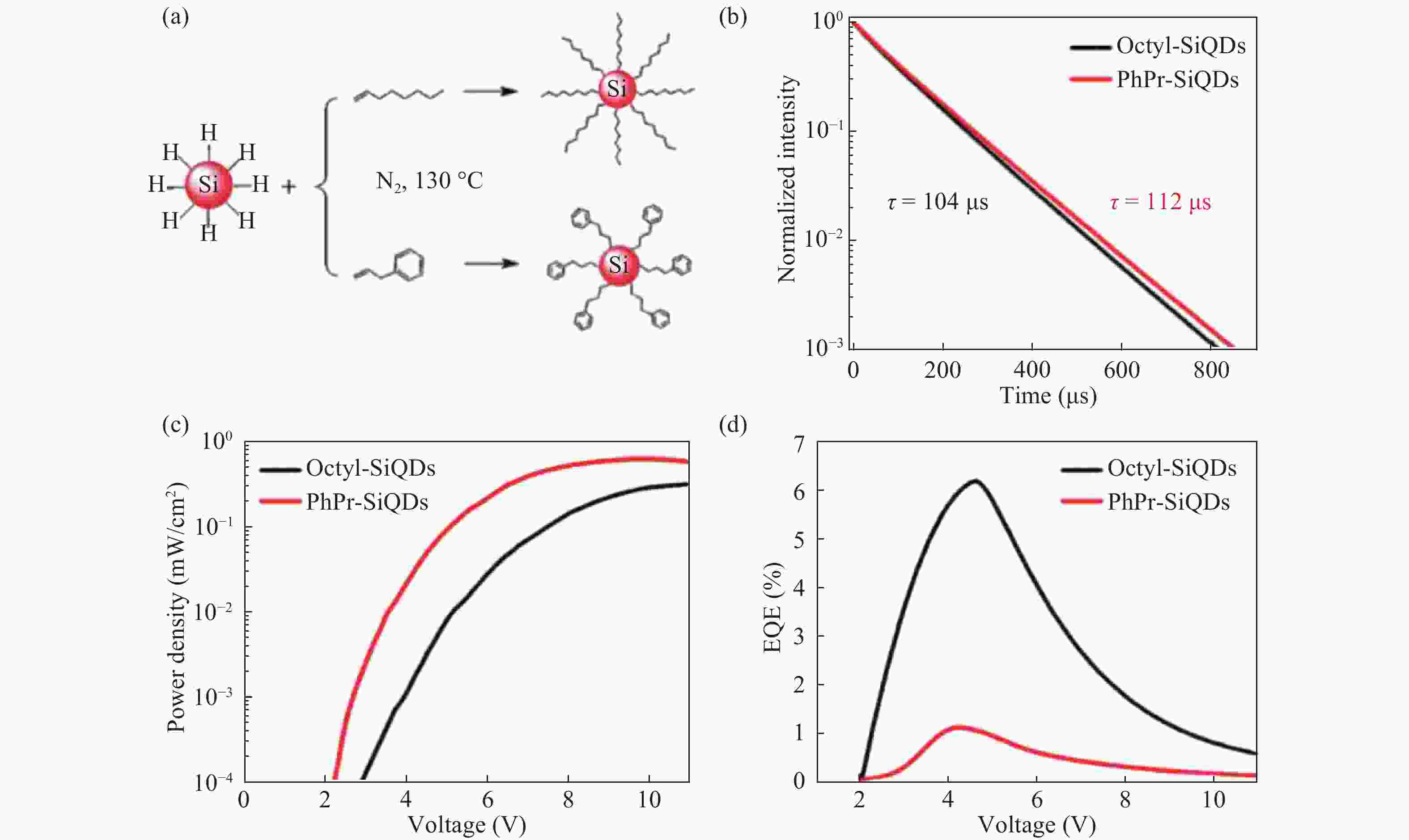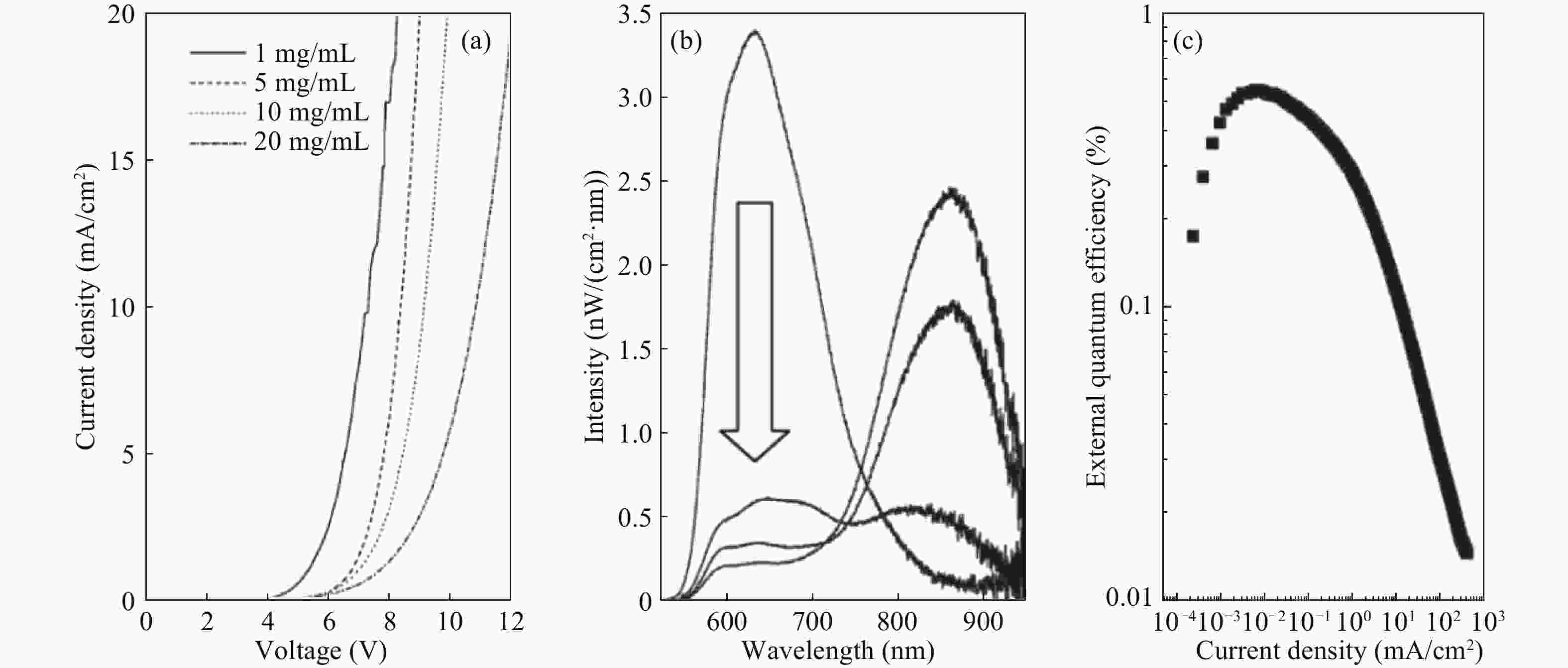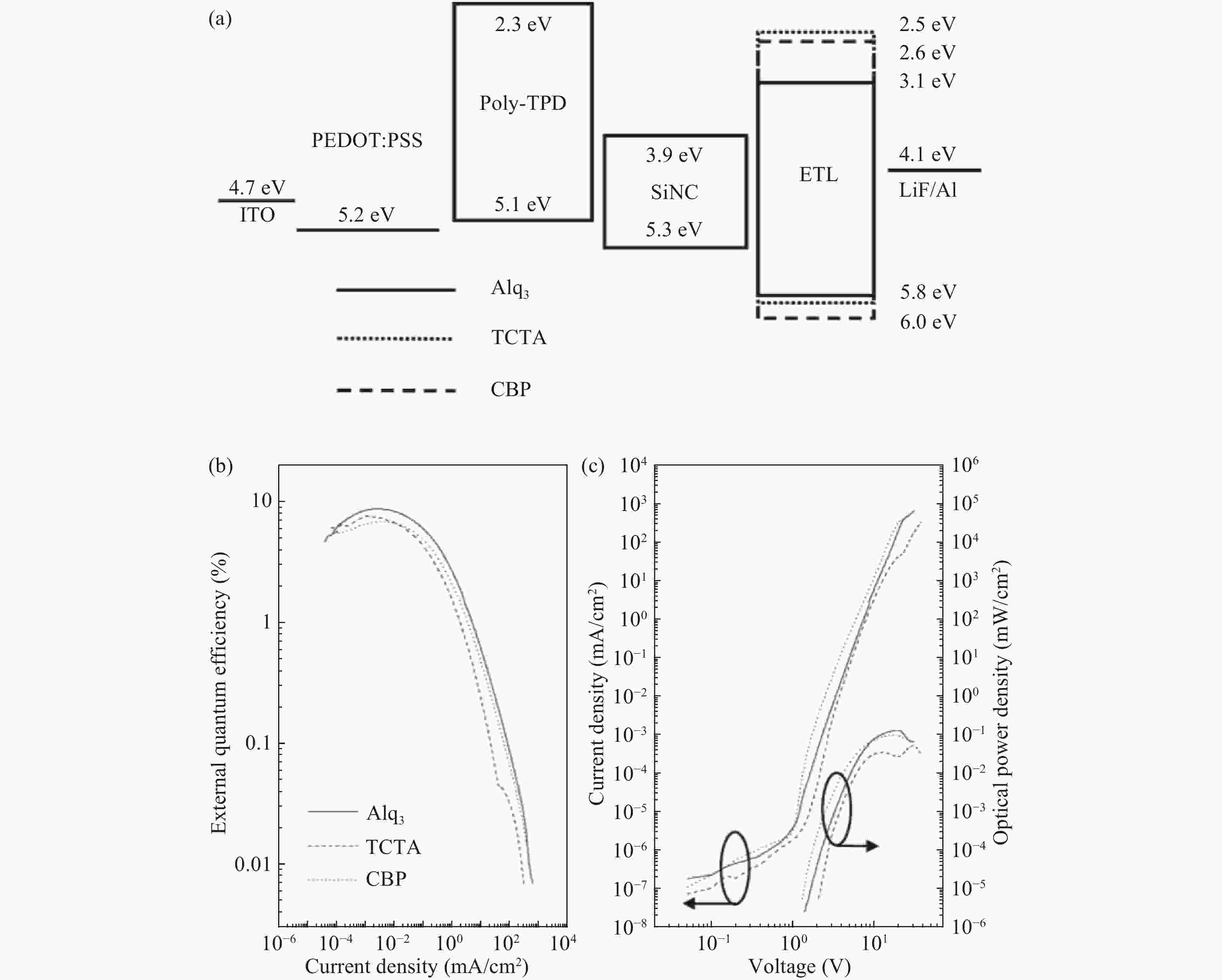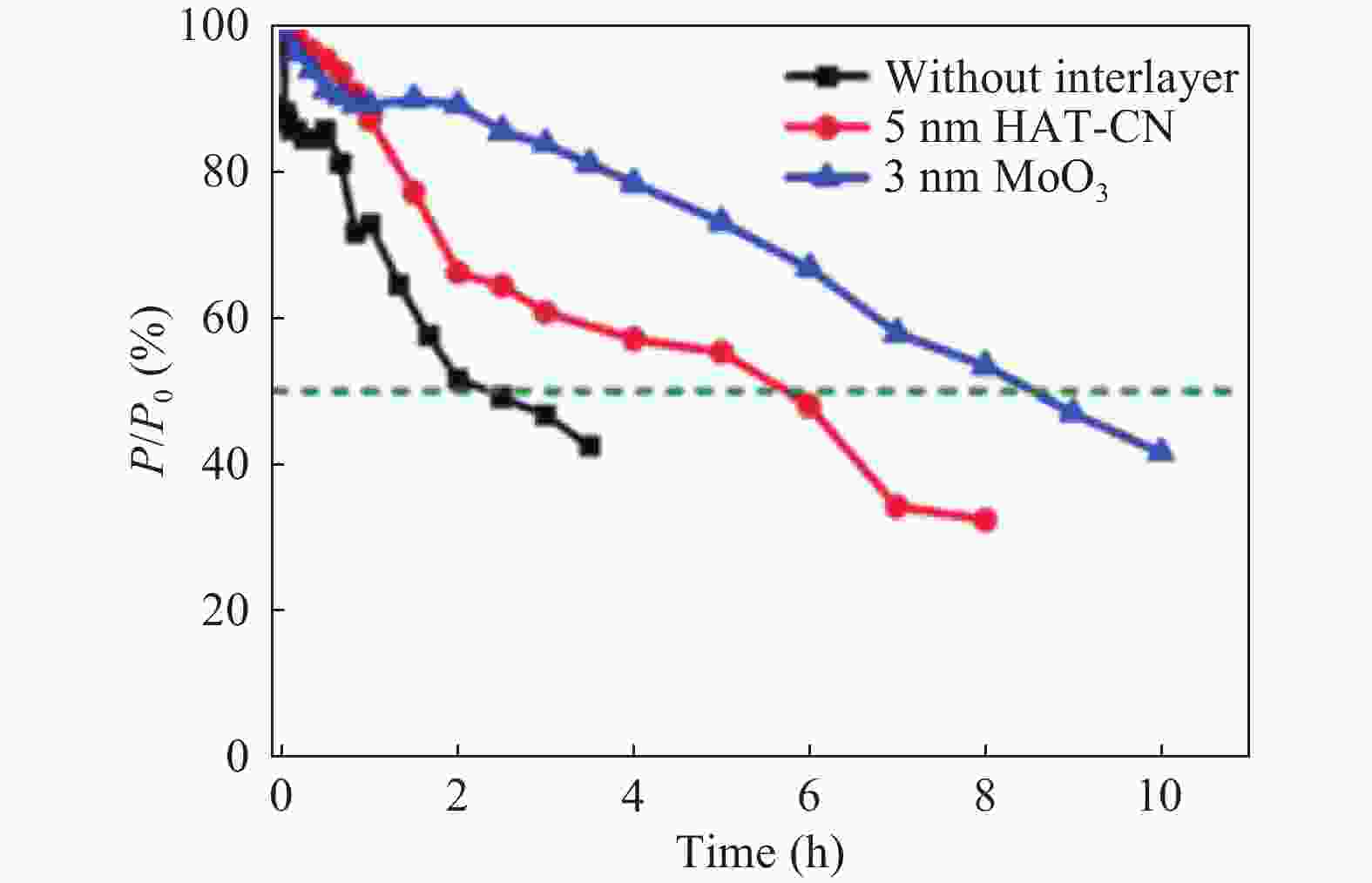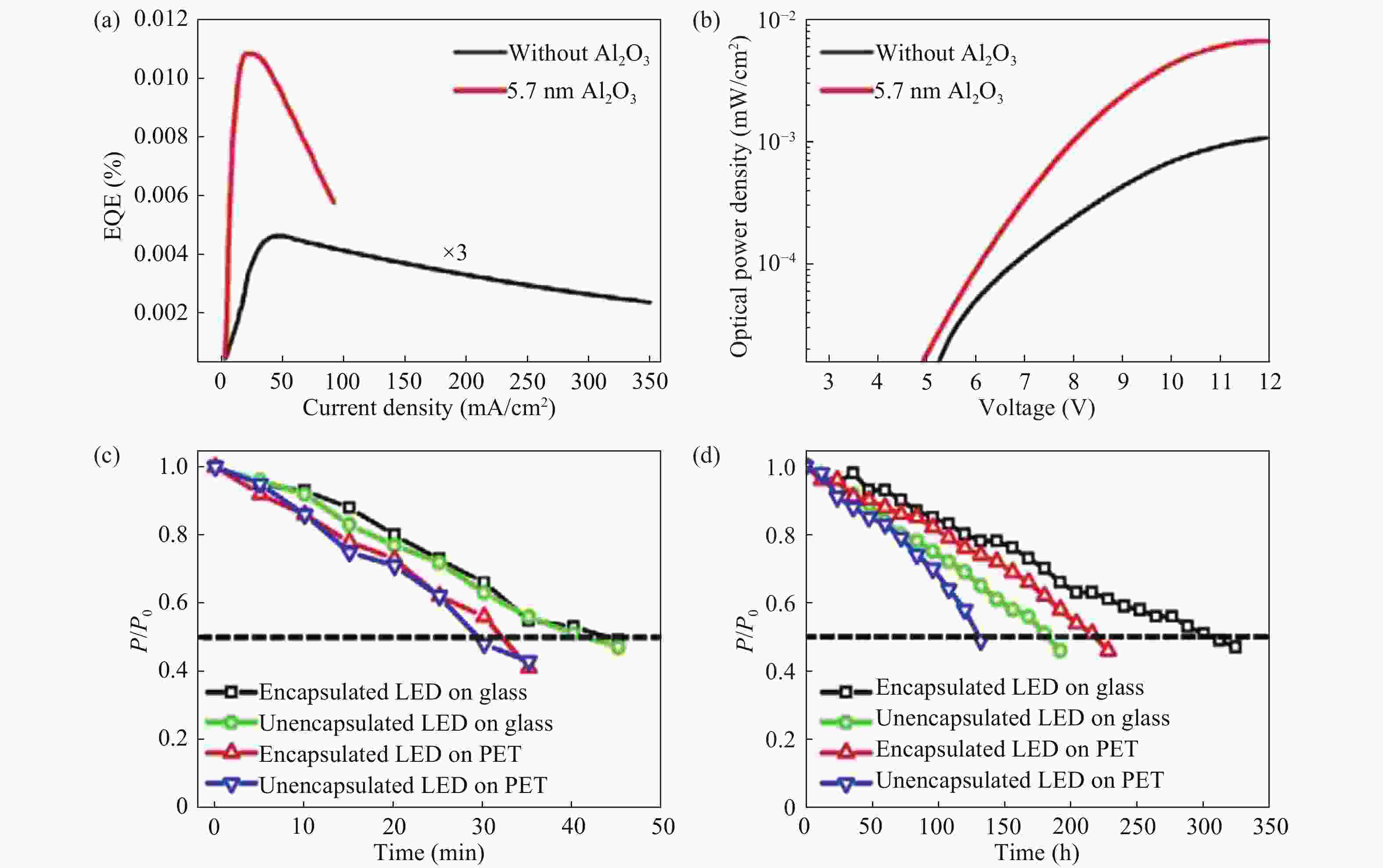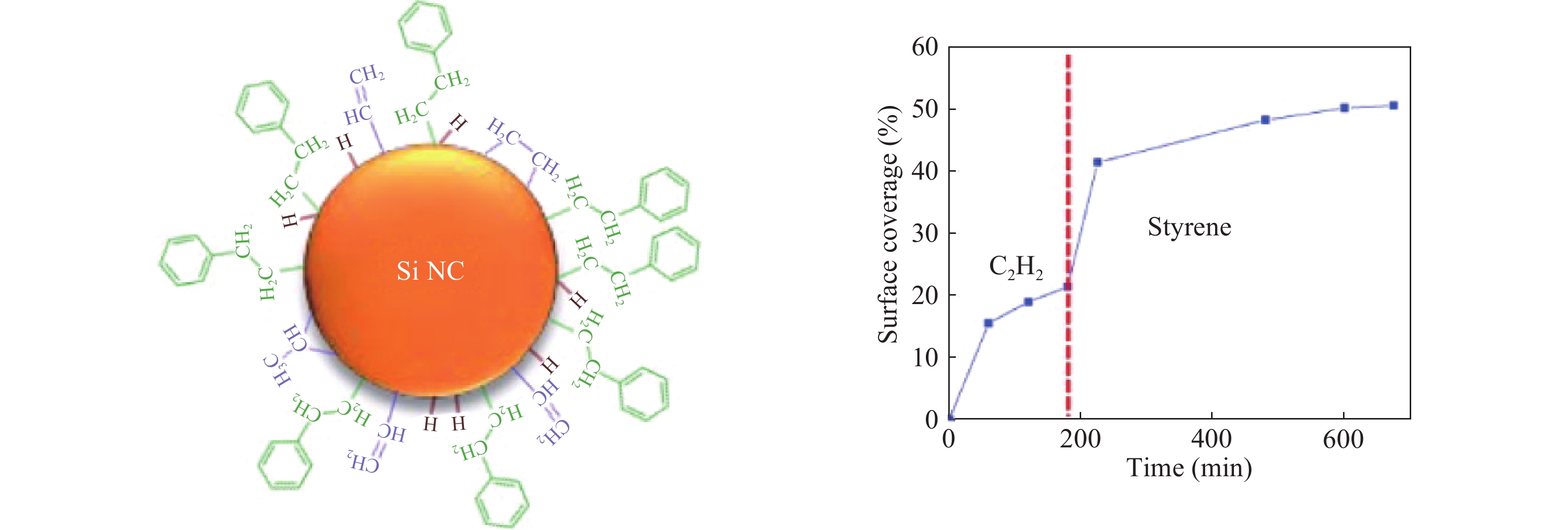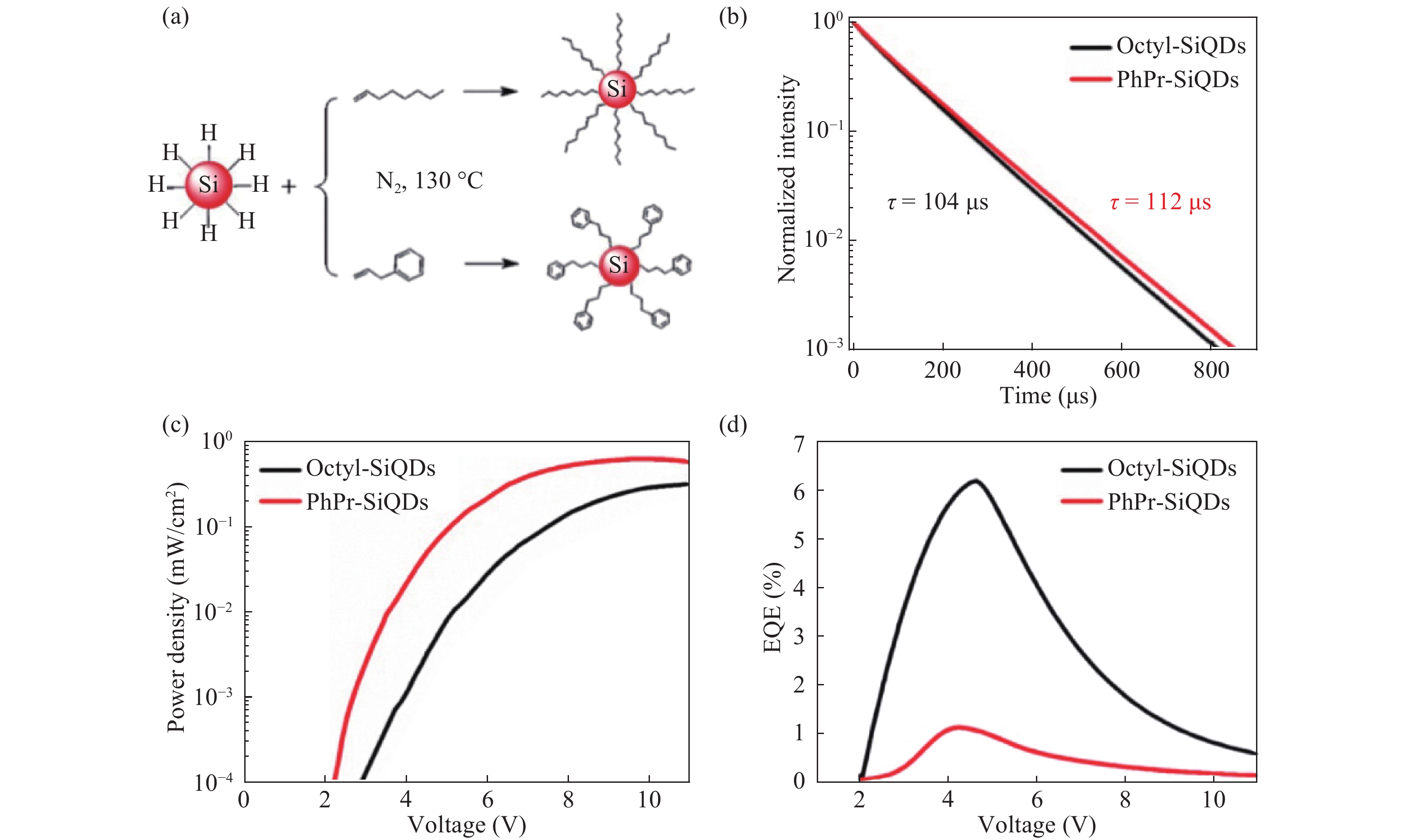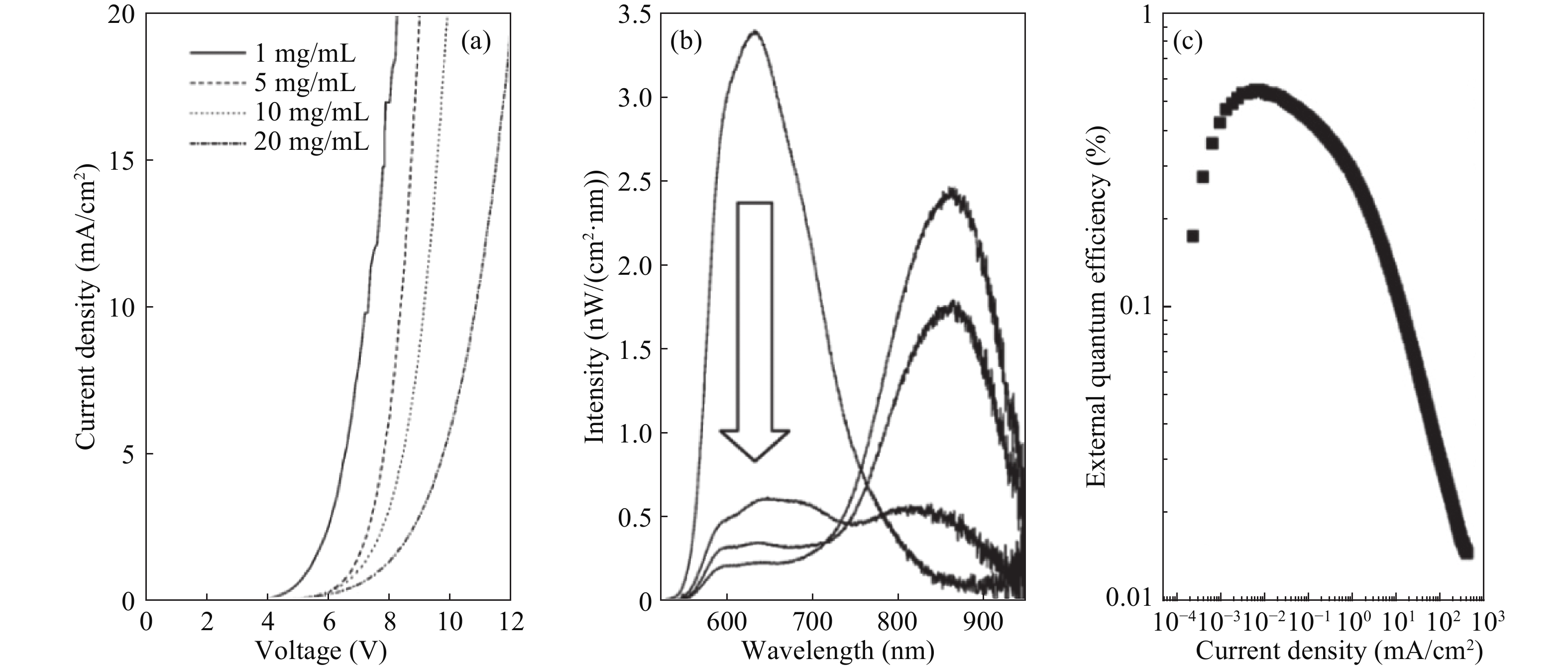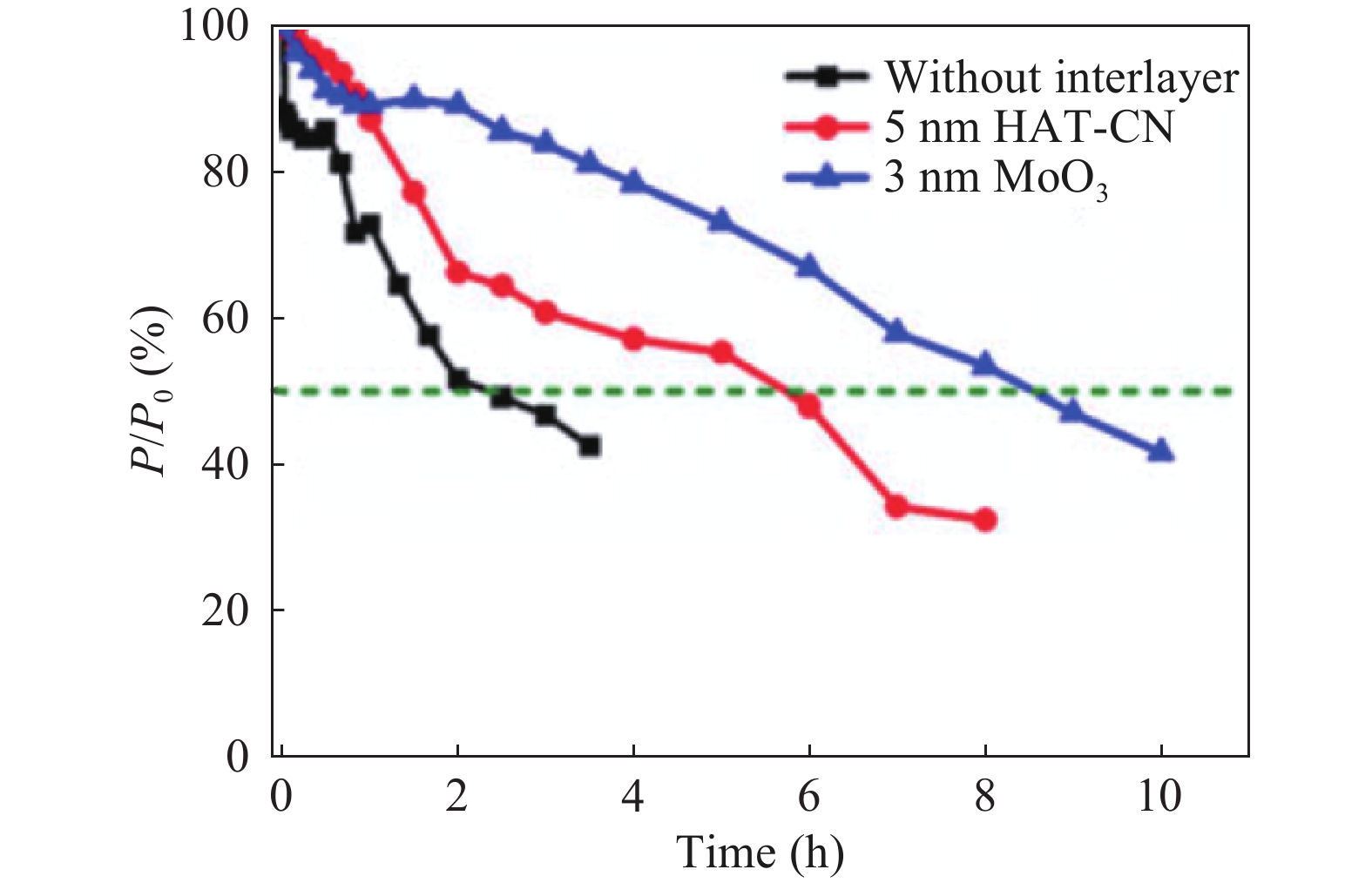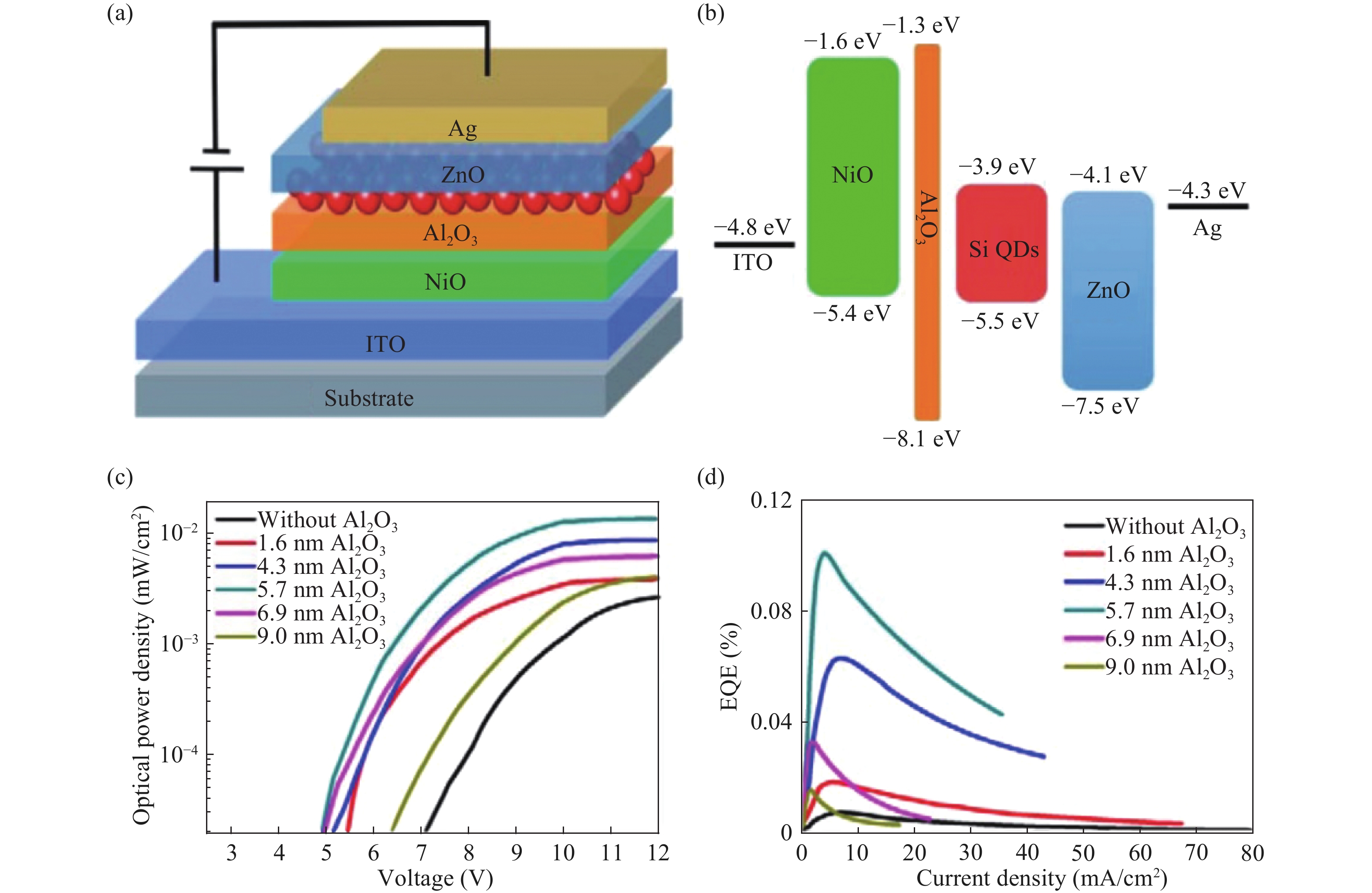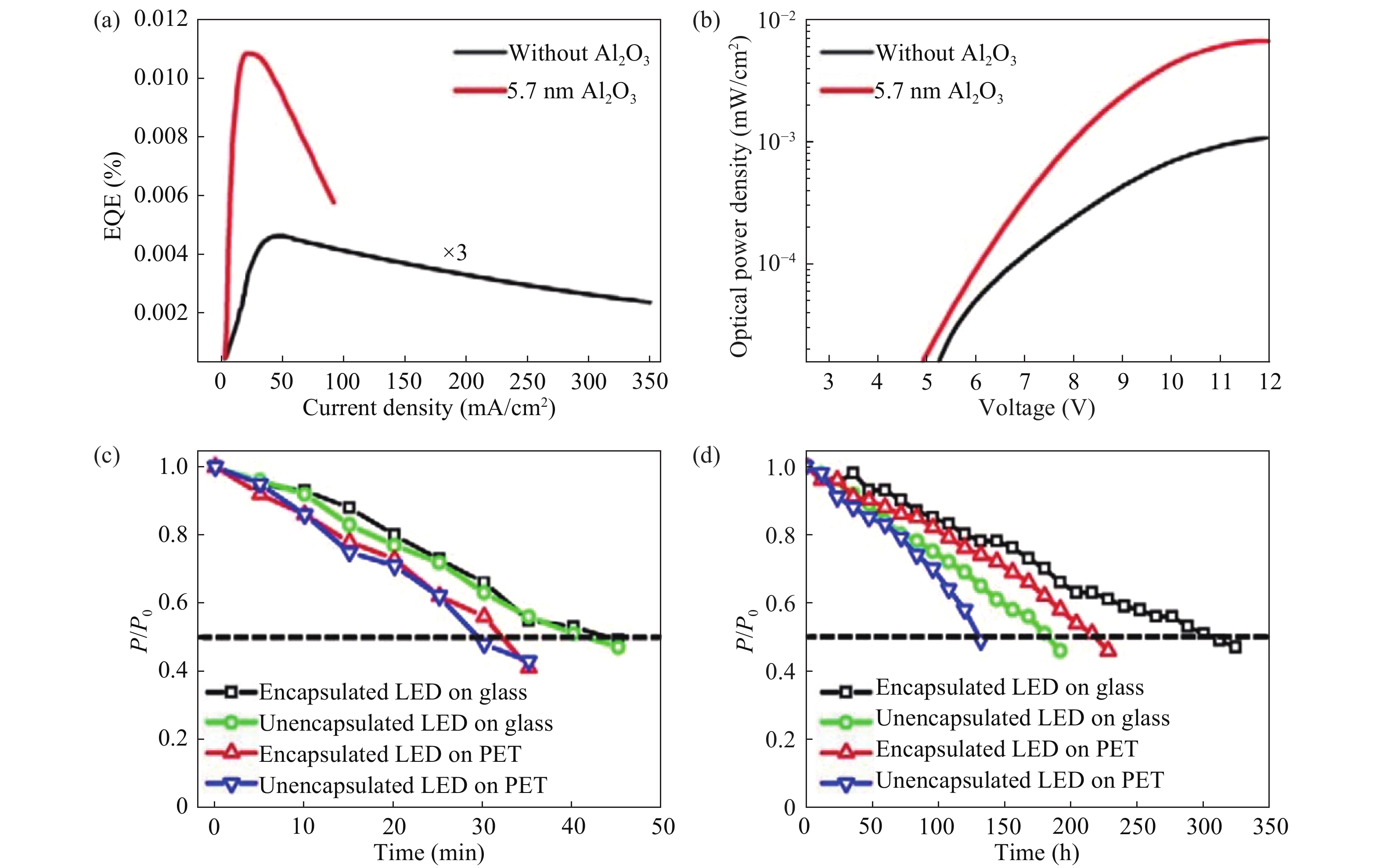| Citation: |
Shuangyi Zhao, Xiangkai Liu, Xiaodong Pi, Deren Yang. Light-emitting diodes based on colloidal silicon quantum dots[J]. Journal of Semiconductors, 2018, 39(6): 061008. doi: 10.1088/1674-4926/39/6/061008
S Y Zhao, X K Liu, X D Pi, D R Yang. Light-emitting diodes based on colloidal silicon quantum dots[J]. J. Semicond., 2018, 39(6): 061008. doi: 10.1088/1674-4926/39/6/061008.
Export: BibTex EndNote
|
Light-emitting diodes based on colloidal silicon quantum dots
doi: 10.1088/1674-4926/39/6/061008
More Information-
Abstract
Colloidal silicon quantum dots (Si QDs) hold great promise for the development of printed Si electronics. Given their novel electronic and optical properties, colloidal Si QDs have been intensively investigated for optoelectronic applications. Among all kinds of optoelectronic devices based on colloidal Si QDs, QD light-emitting diodes (LEDs) play an important role. It is encouraging that the performance of LEDs based on colloidal Si QDs has been significantly increasing in the past decade. In this review, we discuss the effects of the QD size, QD surface and device structure on the performance of colloidal Si-QD LEDs. The outlook on the further optimization of the device performance is presented at the end.-
Keywords:
- quantum dots,
- optoelectronic devices,
- light-emitting diode
-
References
[1] Ni Z, Pi X, Ali M, et al. Freestanding doped silicon nanocrystals synthesized by plasma. J Phys D, 2015, 48(31): 314006 doi: 10.1088/0022-3727/48/31/314006[2] Mangolini L, Kortshagen U. Plasma-assisted synthesis of silicon nanocrystal inks. Adv Mater, 2007, 19(18): 2513 doi: 10.1002/(ISSN)1521-4095[3] Nozaki T, Sasaki K. Microplasma synthesis of tunable photoluminescent silicon nanocrystals. Nanotechnology, 2007, 18(23): 235603 doi: 10.1088/0957-4484/18/23/235603[4] Buuren T V, Dinh L N, Chase L L, et al. Changes in the electronic properties of Si nanocrystals as a function of particle size. Phys Rev Lett, 1998, 80(17): 3803 doi: 10.1103/PhysRevLett.80.3803[5] Liu X, Zhang Y, Yu T, Qiao X, et al. Optimum quantum yield of the light emission from 2 to 10 nm hydrosilylated silicon quantum dots. Particle & Particle Systems Characterization, 2016, 33(1): 44 doi: 10.1002/ppsc.201500148[6] Gresback R, Murakami Y, Ding Y, et al. Optical extinction spectra of silicon nanocrystals: size dependence upon the lowest direct transition. Langmuir, 2013, 29(6): 1802 doi: 10.1021/la3042082[7] Zhou S, Ni Z, Ding Y, et al. Ligand-free, colloidal, and plasmonic silicon nanocrystals heavily doped with boron. ACS Photon, 2016, 3(3): 415 doi: 10.1021/acsphotonics.5b00568[8] Sangghaleh F, Sychugov I, Yang Z, et al. Near-unity internal quantum efficiency of luminescent silicon nanocrystals with ligand passivation. ACS Nano, 2015, 9(7): 7097 doi: 10.1021/acsnano.5b01717[9] Mangolini L, Thimsen E, Kortshagen U. High-yield plasma synthesis of luminescent silicon nanocrystals. Nano Lett, 2005, 5(4): 655 doi: 10.1021/nl050066y[10] Zhong Y, Sun X, Wang S, et al. Facile, large-quantity synthesis of stable, tunable-color silicon nanoparticles and their application for long-term cellular imaging. ACS Nano, 2015, 9(6): 5958 doi: 10.1021/acsnano.5b00683[11] Zhou S, Pi X, Ni Z, et al. Boron- and phosphorus-hyperdoped silicon nanocrystals. Particle & Particle Systems Characterization, 2015, 32(2): 213[12] Fujii M, Mimura A, Hayashi S, et al. Photoluminescence from Si nanocrystals dispersed in phosphosilicate glass thin films: improvement of photoluminescence efficiency. Appl Phys Lett, 1999, 75(2): 184 doi: 10.1063/1.124313[13] Cullis A G, Canham L T. Visible light emission due to quantum size effects in highly porous crystalline silicon. Nature, 1991, 353(6342): 335 doi: 10.1038/353335a0[14] Sham T K, Jiang D T, Coulthard I. Origin of luminescence from porous silicon deduced by synchrotron-light-induced optical luminescence. Nature, 1993, 363: 331 doi: 10.1038/363331a0[15] Takeoka S. Size-dependent photoluminescence from surface-oxidized Si nanocrystals in a weak confinement regime. Phys Rev B, 2000, 62(24): 16820 doi: 10.1103/PhysRevB.62.16820[16] Zhang H, Lin L, Jiang S. Fabrication of nc-Si/SiO2 structure by thermal oxidation method and its luminescence characteristics. Chin Opt Lett, 2009, 7(4): 332 doi: 10.3788/COL[17] Kim T W, Cho C H, Kim B H, et al. Quantum confinement effect in crystalline silicon quantum dots in silicon nitride grown using SiH4 and NH3. Appl Phys Lett, 2006, 88(12): 123102 doi: 10.1063/1.2187434[18] Cao Y, Xu J, Ge Z, et al. Enhanced broadband spectral re- sponse and energy conversion efficiency for hetero-junction solar cells with graded-sized Si quantum dots/SiC multilayers. J Mater Chem C, 2015, 3(46): 12061 doi: 10.1016/j.tsf.2009.12.009[19] Rui Y, Li S, Xu J, et al. Size-dependent electroluminescence from Si quantum dots embedded in amorphous SiC matrix. J Appl Phys, 2011, 110(6): 064322 doi: 10.1063/1.1866638[20] Rui Y, Li S, Xu J, et al. Comparative study of electrolumines- cence from annealed amorphous SiC single layer and amorph- ous Si/SiC multilayers. J Non-Cryst Solids, 2012, 358(17): 2114 doi: 10.1116/1.2756556[21] Song D, Cho E C, Cho Y H, et al. Evolution of Si (and SiC) nanocrystal precipitation in SiC matrix. Thin Solid Films, 2008, 516(12): 3824 doi: 10.1016/j.tsf.2007.06.150[22] Holmes J D, Ziegler K J, Doty R C, et al. Highly luminescent silicon nanocrystals with discrete optical transitions. J Am Chem Soc, 2001, 123: 3743 doi: 10.1021/ja002956f[23] Pettigrew K A, Liu Q, Power P P, et al. Solution synthesis of alkyl- and alkyl/alkoxy-capped silicon nanoparticles via oxidation of Mg2Si. Chem Mater, 2003, 15: 4005 doi: 10.1021/cm034403k[24] Niesar S, Pereira R N, Stegner A R, et al. Low-cost post-growth treatments of crystalline silicon nanoparticles improving surface and electronic properties. Adv Funct Mater, 2012, 22(6): 1190 doi: 10.1002/adfm.v22.6[25] Zhou S, Pi X, Ni Z, et al. Comparative study on the localized surface plasmon resonanace of boron and phosphorous doped silicon nanocrystals. ACS Nano, 2015, 9(1): 378 doi: 10.1021/nn505416r[26] Pi X, Zhang L, Yang D. Enhancing the efficiency of multicrystalline silicon solar cells by the inkjet printing of silicon-quantum-dot ink. J Phys Chem C, 2012, 116(40): 21240 doi: 10.1021/jp307078g[27] Yu T, Wang F, Xu Y, Ma L, et al. Graphene coupled with silicon quantum dots for high-performance bulk-silicon-based Schottky-junction photodetectors. Adv Mater, 2016, 28(24): 4912 doi: 10.1002/adma.v28.24[28] Liu C, Holman Z C, Kortshagen U R. Optimization of Si NC/P3HT hybrid solar cells. Adv Funct Mater, 2010, 20(13): 2157 doi: 10.1002/adfm.v20:13[29] Ding Y, Sugaya M, Liu Q, et al. Oxygen passivation of silicon nanocrystals: Influences on trap states, electron mobility, and hybrid solar cell performance. Nano Energy, 2014, 10: 322 doi: 10.1016/j.nanoen.2014.09.031[30] Ni Z, Ma L, Du S, et al. Plasmonic silicon quantum dots enabled high-sensitivity ultrabroadband photodetection of graphene-based hybrid phototransistors. ACS Nano, 2017, 11(10): 9854 doi: 10.1021/acsnano.7b03569[31] Ding Y, Gresback R, Liu Q, et al. Silicon nanocrystal conjugated polymer hybrid solar cells with improved performance. Nano Energy, 2014, 9: 25 doi: 10.1016/j.nanoen.2014.06.024[32] Švrček V, Cook S, Kazaoui S, et al. Silicon nanocrystals and semiconducting single-walled carbon nanotubes applied to photovoltaic cells. J Phys Chem Lett, 2011, 2(14): 1646 doi: 10.1021/jz200680v[33] Zhao S, Pi X, Mercier C, et al. Silicon-nanocrystal-incorporated ternary hybrid solar cells. Nano Energy, 2016, 26: 305 doi: 10.1016/j.nanoen.2016.05.040[34] Ni Z, Pi X, Zhou S, et al. Size-dependent structures and optical absorption of boron-hyperdoped silicon nanocrystals. Adv Opt Mater, 2016, 4(5): 700 doi: 10.1002/adom.v4.5[35] Lin T, Liu X, Zhou B, et al. A Solution-processed UV-sensitive photodiode produced using a new silicon nanocrystal ink. Adv Funct Mater, 2014, 24(38): 6016 doi: 10.1002/adfm.201400600[36] Pi X, Li Q, Li D, et al. Spin-coating silicon-quantum-dot ink to improve solar cell efficiency. Sol Energy Maters Sol Cells, 2011, 95(10): 2941 doi: 10.1016/j.solmat.2011.06.010[37] Mastronardi M L, Henderson E J, Puzzo D P, et al. Silicon nanocrystal OLEDs: effect of organic capping group on performance. Small, 2012, 8(23): 3647 doi: 10.1002/smll.v8.23[38] Dai X, Zhang Z, Jin Y, et al. Solution-processed, high-performance light-emitting diodes based on quantum dots. Nature, 2014, 515(7525): 96 doi: 10.1038/nature13829[39] Pan J, Chen J, Huang Q, et al. Size tunable ZnO nanoparticles to enhance electron injection in solution processed QLEDs. ACS Photon, 2016, 3(2): 215 doi: 10.1021/acsphotonics.5b00267[40] Dai X, Deng Y, Peng X, et al. Quantum-dot light-emitting diodes for large-area displays: towards the dawn of commercialization. Adv Mater, 2017, 29(14): 1607022 doi: 10.1002/adma.v29.14[41] Forrest S R, Bradley D D C, Thompson M E. Measuring the efficiency of organic light-emitting devices. Adv Mater, 2003, 15(13): 1043 doi: 10.1002/adma.200302151[42] Rogach A L, Gaponik N, Lupton J M, et al. Light-emitting diodes with semiconductor nanocrystals. Angew Chem Int Ed Engl, 2008, 47(35): 6538 doi: 10.1002/anie.v47:35[43] Kwak J, Lim J, Park M, et al. High-power genuine ultraviolet light-emitting diodes based on colloidal nanocrystal quantum dots. Nano Lett, 2015, 15(6): 3793 doi: 10.1021/acs.nanolett.5b00392[44] Cho K, Lee E, Joo W, et al. High-performance crosslinked colloidal quantum-dot light-emitting diodes. Nat Photon, 2009, 3(6): 341 doi: 10.1038/nphoton.2009.92[45] Bansal A K, Antolini F, Zhang S, et al. Highly luminescent colloidal CdS quantum dots with efficient near-infrared electroluminescence in light-emitting diodes. J Phys Chem C, 2016, 120(3): 1871 doi: 10.1021/acs.jpcc.5b09109[46] Lee K, Han C, Kang H, et al. Highly efficient, color-reproducible full-color electroluminescent devices based on red/green/blue quantum dot-mixed multilayer. ACS Nano, 2015, 9(11): 10941 doi: 10.1021/acsnano.5b05513[47] Mashford B S, Stevenson M, Popovic Z, et al. High-efficiency quantum-dot light-emitting devices with enhanced charge injection. Nat Photon, 2013, 7: 407 doi: 10.1038/nphoton.2013.70[48] Zou Y, Ban M, Cui W, et al. A general solvent selection strategy for solution processed quantum dots targeting high performance light-emitting diode. Adv Funct Mater, 2017, 27(1): 1603325 doi: 10.1002/adfm.v27.1[49] Brovelli S, Chiodini N, Lorenzi R, et al. Fully inorganic oxide-in-oxide ultraviolet nanocrystal light emitting devices. Nat Commun, 2012, 3: 690 doi: 10.1038/ncomms1683[50] Shirasaki Y, Supran G J, Bawendi M G, et al. Emergence of colloidal quantum-dot light-emitting technologies. Nat Photon, 2012, 7(1): 13[51] Tessler N, Medvedev V, Kazes M, et al. Efficient near-infrared polymer nanocrystal light-emitting diodes. Science, 2002, 295(22): 1566[52] Cheng X, Lowe S B, Reece P J, et al. Colloidal silicon quantum dots: from preparation to the modification of self-assembled monolayers (SAMs) for bio-applications. Chem Soc Rev, 2014, 43(8): 2680 doi: 10.1039/C3CS60353A[53] Caruge J M, Halpert J E, Wood V, et al. Colloidal quantum-dot light-emitting diodes with metal-oxide charge transport layers. Nat Photon, 2008, 2(4): 247 doi: 10.1038/nphoton.2008.34[54] Pi X D, Mangolini L, Campbell S A, et al. Room-temperature atmospheric oxidation of Si nanocrystals after HF etching. Phys Rev B, 2007, 75(8): 086423[55] Gupta A, Wiggers H. Surface chemistry and photoluminescence property of functionalized silicon nanoparticles. Physica E, 2009, 41(6): 1010 doi: 10.1016/j.physe.2008.08.033[56] Anthony R J, Rowe D J, Stein M, et al. Routes to achieving high quantum yield luminescence from gas-phase-produced silicon nanocrystals. Adv Funct Mater, 2011, 21(21): 4042 doi: 10.1002/adfm.v21.21[57] Hua F, Swihart M T, Ruckenstein E. Efficient surface grafting of luminescent silicon quantum dots by photoinitiated hydrosilylation. Langmuir, 2005, 21: 6054 doi: 10.1021/la0509394[58] Pi X, Yu T, Yang D. Water-dispersible silicon-quantum-dot-containing micelles self-assembled from an amphiphilic polymer. Particle & Particle Systems Characterization, 2014, 31(7): 751[59] Purkait T K, Iqbal M, Wahl M H, et al. Borane-catalyzed room-temperature hydrosilylation of alkenes/alkynes on silicon nanocrystal surfaces. J Am Chem Soc, 2014, 136(52): 17914 doi: 10.1021/ja510120e[60] Kovalev D, Heckler H, Ben-Chorin M, et al. Breakdown of the k-conservation rule in Si nanoparticle. Phys Rev Lett, 1998, 81(13): 2803 doi: 10.1103/PhysRevLett.81.2803[61] Dasog M, Yang Z, Regli S, et al. Chemical insight into the origin of red and blue photoluminescence arising from freestanding silicon nanocrystals. ACS Nano, 2013, 7(3): 2676 doi: 10.1021/nn4000644[62] Nelles J, Sendor D, Ebbers A, et al. Functionalization of silicon nanoparticles via hydrosilylation with 1-alkenes. Colloid Polym Sci, 2007, 285(7): 729 doi: 10.1007/s00396-006-1622-4[63] Weeks S L, Macco B, van de Sanden M C, et al. Gas-phase hydrosilylation of plasma-synthesized silicon nanocrystals with short- and long-chain alkynes. Langmuir, 2012, 28(50): 17295 doi: 10.1021/la3030952[64] Jurbergs D, Rogojina E, Mangolini L, et al. Silicon nanocrystals with ensemble quantum yields exceeding 60%. Appl Phys Lett, 2006, 88(23): 233116 doi: 10.1063/1.2210788[65] Yang Z, Dasog M, Dobbie A R, et al. Highly luminescent covalently linked silicon nanocrystal/polystyrene hybrid functional materials: synthesis, properties, and processability. Adv Funct Mater, 2014, 24(10): 1345 doi: 10.1002/adfm.v24.10[66] Mastronardi M L, Chen K K, Liao K, et al. Size-dependent chemical reactivity of silicon nanocrystals with water and oxygen. J Phys Chem C, 2015, 119(1): 826 doi: 10.1021/jp510592j[67] Rinck J, Schray D, Kubel C, et al. Size-dependent oxidation of monodisperse silicon nanocrystals with allylphenylsulfide surfaces. Small, 2015, 11(3): 335 doi: 10.1002/smll.v11.3[68] Jariwala B N, Dewey O S, Stradins P, et al. In situ gas-phase hydrosilylation of plasma-synthesized silicon nanocrystals. ACS Appl Mater Interfaces, 2011, 3(8): 3033 doi: 10.1021/am200541p[69] Hessel C M, Reid D, Panthani M G, et al. Synthesis of ligand-stabilized silicon nanocrystals with size-dependent photoluminescence spanning visible to near-infrared wavelengths. Chem Mater, 2012, 24(2): 393 doi: 10.1021/cm2032866[70] Mastronardi M L, Maier-Flaig F, Faulkner D, et al. Size-dependent absolute quantum yields for size-separated colloidally-stable silicon nanocrystals. Nano Lett, 2012, 12(1): 337 doi: 10.1021/nl2036194[71] Dasog M, Reyes G B, Titova L V, et al. Size vs. Surface tuning the photoluminescence of freestanding silicon nanocrystals across the visible spectrum via surface groups. ACS Nano, 2014, 8(9): 9636 doi: 10.1021/nn504109a[72] Locritani M, Yu Y, Bergamini G, et al. Silicon nanocrystals functionalized with pyrene units: efficient light-harvesting antennae with bright near-infrared emission. J Phys Chem Lett, 2014, 5(19): 3325 doi: 10.1021/jz501609e[73] Li Q, Luo T Y, Zhou M, et al. Silicon nanoparticles with surface nitrogen: 90% quantum yield with narrow luminescence bandwidth and the ligand structure based energy law. ACS Nano, 2016, 10(9): 8385 doi: 10.1021/acsnano.6b03113[74] Liu X, Ni Z, Zhao S, et al. Light-emitting diodes based on colloidal silicon quantum dots with octyl and phenylpropyl ligands. ACS Appl Mater Inter, 2018, 10(6): 5959 doi: 10.1021/acsami.7b16980[75] Maier-Flaig F, Rinck J, Stephan M, et al. Multicolor silicon light-emitting diodes (SiLEDs). Nano Lett, 2013, 13(2): 475 doi: 10.1021/nl3038689[76] Maier-Flaig F, Kubel C, Rinck J, et al. Looking inside a working SiLED. Nano Lett, 2013, 13(8): 3539 doi: 10.1021/nl400975u[77] Cheng K Y, Anthony R, Kortshagen U R, et al. Hybrid silicon nanocrystal-organic light-emitting devices for infrared electroluminescence. Nano Lett, 2010, 10(4): 1154 doi: 10.1021/nl903212y[78] Puzzo D P, Henderson E J, Helander M G, et al. Visible colloidal nanocrystal silicon light-emitting diode. Nano Lett, 2011, 11(4): 1585 doi: 10.1021/nl1044583[79] Cheng K Y, Anthony R, Kortshagen U R, et al. High-efficiency silicon nanocrystal light-emitting devices. Nano Lett, 2011, 11(5): 1952 doi: 10.1021/nl2001692[80] Gu W, Liu X, Pi X, et al. Silicon-quantum-dot light-emitting diodes with interlayer-enhanced hole transport. IEEE Photon J, 2017, 9(2): 1[81] Zhao S, Liu X, Gu W, et al. Al2O3-interlayer-enhanced performance of all-inorganic silicon-quantum-dot near-infrared light-emitting diodes. IEEE Trans Electron Device, 2018, 65: 577 doi: 10.1109/TED.2017.2782772[82] Yao L, Yu T, Ba L, et al. Efficient silicon quantum dots light emitting diodes with an inverted device structure. J Mater Chem C, 2016, 4: 673 doi: 10.1039/C5TC03064A[83] Kim Y, Han T, Cho H, et al. Polyethylene imine as an ideal interlayer for highly efficient inverted polymer light-emitting diodes. Adv Funct Mater, 2014, 24: 3808 doi: 10.1002/adfm.v24.24 -
Proportional views






 DownLoad:
DownLoad:


